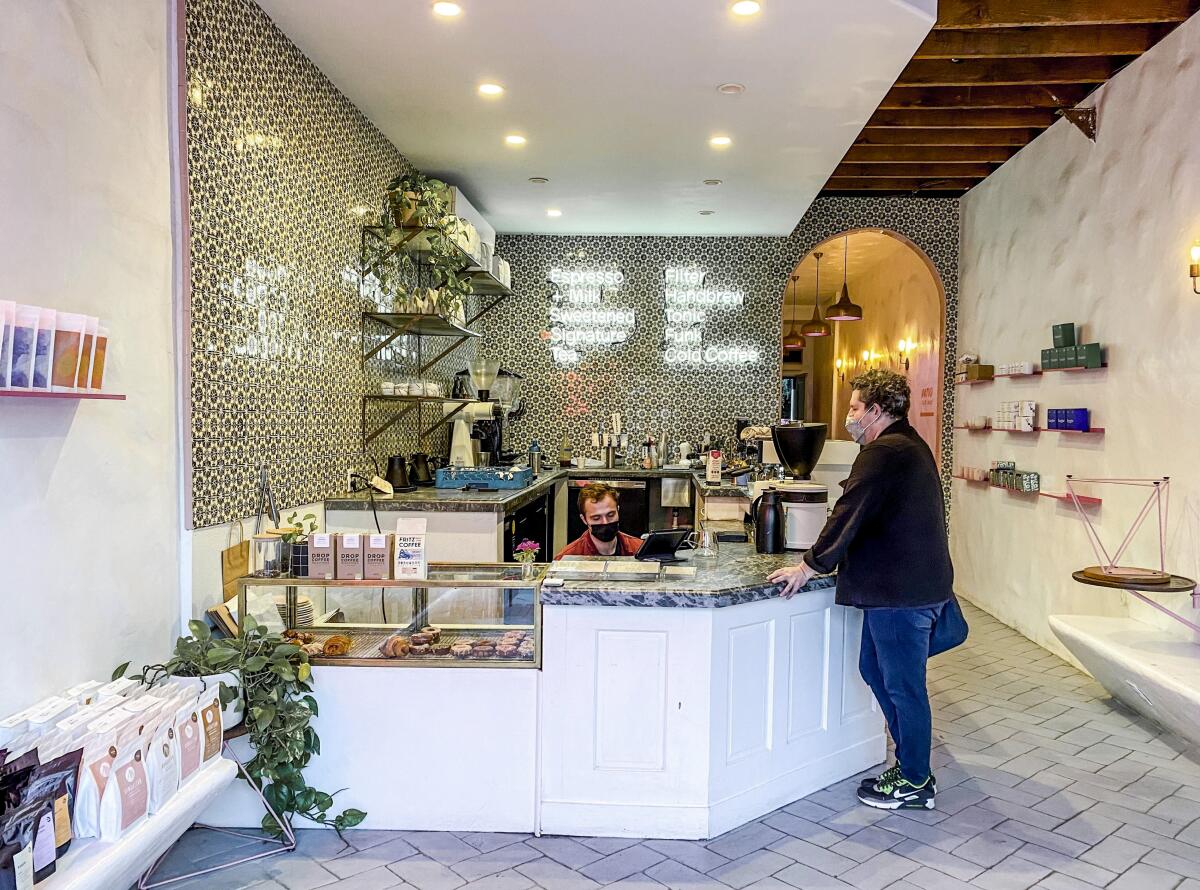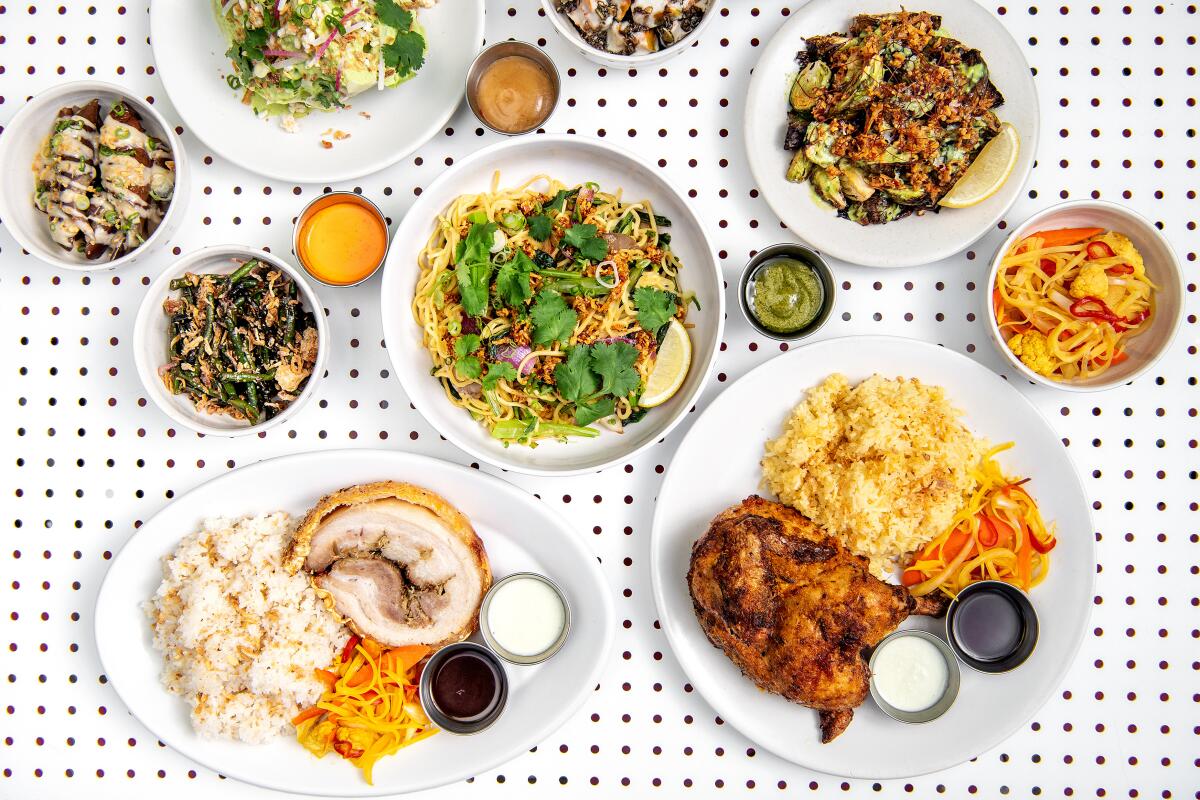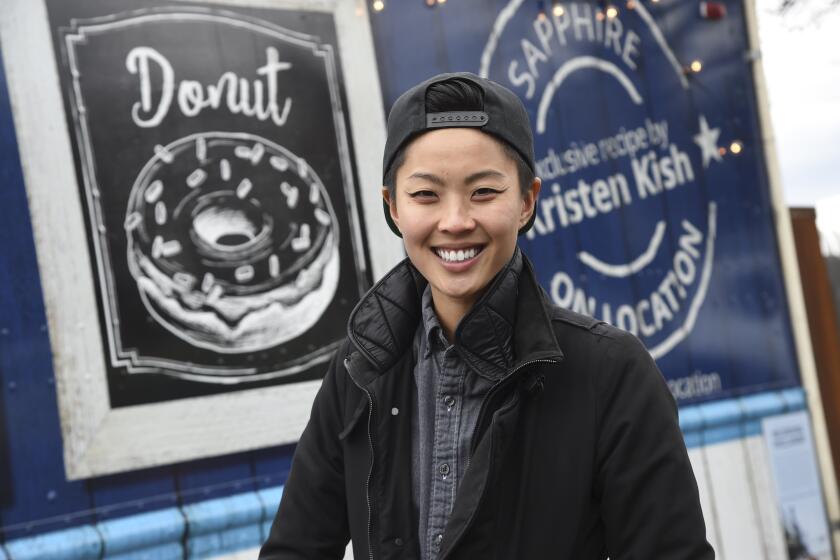The best cup of coffee I’ve ever made

- Share via
I’ve come late to a zeal for coffee. I was — am — more of a serious tea person, forever enthralled by the infinite flavor variations that oxidation, roasting and fermentation can tease out of the leaves of the Camellia sinensis plant. (And equally aware of how sleep-inducing the subject is to many people.)
Coffee was about the jolt, and before 2020, something I never made for myself at home. The poor coffee-drinking friends who came for visits had to wrangle a French press dug out of the back of a cabinet full of appliances; I kept a bag of ground beans in the freezer for such emergency occasions.
Enjoying this newsletter? Consider subscribing to the Los Angeles Times
Your support helps us deliver the news that matters most. Become a subscriber.
Besha Rodell, the former restaurant critic for LA Weekly, first guided me to appreciate espresso. We’ve known each other since our way-back days in Atlanta. I think we were traveling through the South together circa 2009, and after a huge lunch, maybe two of them, she found a decent coffeeshop and ordered a macchiato. Dragging, I said I’d have one too. Aha: I liked the way the splotch of foamed milk cut the espresso’s bitterness. That became an occasional afternoon pick-me-up.
It was only during my constant travels as Eater’s national critic last decade that I became, if not reliant, then helpfully prodded by coffee in the morning. Skipping through time zones multiple times a week will drive a soul toward higher doses of caffeine. Visiting ambitious coffeeshops across the United States — with their curated vibes, the quirky playlists that clearly reflected a staffer’s tastes, and their devotion to roasters whose names I hadn’t heard before — became part of the routine. I appreciated foam art; I more valued when the espresso was unusually smooth and tasted of something more than astringency.
Eat your way across L.A.
Get our weekly Tasting Notes newsletter for reviews, news and more.
You may occasionally receive promotional content from the Los Angeles Times.
Still, coffee was something foreign to my own kitchen. Plenty of friends I stayed with had Nespresso machines; I was grateful for the fast wake-up thunderbolt they threw my way. A man I dated near the end of those years had a gleaming silver Breville contraption called the Oracle, with all the grinding-steaming-extraction bells and whistles. He knew how to use it too, knocking out drinks fast and meticulously. A latte guy, he seemed amused when I wanted nothing more than a dollop of foam atop my double espresso shots.
Really, though, in coffee shops, I’d become way more interested in pour-overs. Not surprising, probably, for a tea person. Carefully made pour-overs deliver the same subtle expressions as carefully steeped tea leaves. I soon realized the depths of coffee culture in Los Angeles when I settled in as a resident late in 2018. Drift, a magazine about the world of coffee, devoted a recent issue to Los Angeles, highlighting roasters and baristas and shop owners with an eye to the city’s defining pluralism. Among those profiled is Jack Benchakul, the owner-barista of Endorffeine in Chinatown’s Far East Plaza complex. If you are dubious about pour-overs — their relative light texture, the admittedly fiddly and time-consuming process of making them — I will send you first to Benchakul. His peerless skills will likely convince you of their beauty.

How one makes great coffee at home, particularly after encountering masters like Benchakul, remained a mystery. Alone in my apartment during the March 2020 shutdowns, it was time to learn. I subscribed to an every-other-week delivery for beans from Bar Nine in Culver City, whose pour-overs I had enjoyed pre-pandemic. I bought a Chemex and a metal reusable filter, because that’s what I watched them use at Bar Nine, though metal filters let a lot of oils seep through, and the cups I made had a ring of sludge at the bottom of them.
After a few months, my geekiest coffee friend directed me to a next-level setup: a Hario V60 pour-over coffee maker (which is also what Benchakul uses in his shop), a Baratza Encore burr grinder and a scale. He connected me with Matthew Jung-Quillen, the chief business officer of Brooklyn-based Sey Coffee who lives in L.A. Jung-Quillen kindly gave me a tutorial on bean-to-water ratios and how to time a cup to about 3½ minutes. I’d watched instructive videos but absorbed the technique better learning from an actual person.
Dayglow Coffee in Silver Lake is near home, and I was attracted to its approach of selling beans (including Sey) from roasters around the world. Owner Tohm Ifergan, born in Mexico and raised in Chicago, was a touring musician in his 20s and also fell in love with coffee through traveling. He likens the multi-roaster retail model to a wine shop, though he also thinks of Dayglow as an import business. Selling beans online and in the shop (there’s a second location in West Hollywood) is an obvious way to move perishable product beyond preparing drinks behind the bar.
Through Dayglow I found Manhattan Coffee Roasters, an operation in the Netherlands run by veteran baristas Esther Maasdam and Ben Morrow. Ifergan told me that they’re known for encouraging farmers to experiment with their growing methods. There remains a universe of knowledge about coffee for me to grasp: differences in varietals, the effects of natural versus washed processing, the nuances of roasting levels. But I know what tastes good to me. A couple of months ago, I treated myself to a bag of Manhattan’s Luna Bermudez; the beans were grown by farmer Diego Bermudez in Colombia, and he requested that the finished product be named after his eldest daughter.
The tasting notes on the bag of Luna Bermudez read, “blueberry Pop-Tart, yellow peach, custard.” Hello, sold. I had more than a year’s worth of daily practice making pour-overs at home by then, and I could genuinely discern those flavors, especially the peach and custard. It was a wild, disarming, peak pleasure.
Like tea, pour-overs have a certain meditative quality to their preparation — a few minutes of paying attention at the start of the day, a bit of patience paying off, the rewards of repetition reaped. The thing about buying beans from shops like Dayglow is that the inventory never stays the same. I buy something, I brew it, I love it, it’s gone and that’s OK. Something else, something fresh is always on the way.
Have a question?
Other stories
My review this week is of Lasita, the wonderful Filipino rotisserie and natural wine bar in Chinatown’s Far East Plaza. Crackling-skinned lechon and bright Catalan reds (among many other varietals) make for a very compelling combination.
Jenn Harris writes about celebrating Lunar New Year via the delight of longevity noodles, plus Julie Giuffrida rounds up essential recipes for observing the occasion at home.
Christopher Reynolds has an in-depth story on San Francisco’s changing Chinatown.
For his series on preserving fruit called “L.A. in a Jar,” Ben Mims has the ultimate primer on marmalade, including the “plate test.” Thinking I’ll try my hand this year using blood oranges.
Stephanie Breijo has the details on UCLA’s new institute dedicated to food studies. She also talks with chefs and restaurant owners about operating their businesses through the Omicron roller-coaster ride.

Eat your way across L.A.
Get our weekly Tasting Notes newsletter for reviews, news and more.
You may occasionally receive promotional content from the Los Angeles Times.



